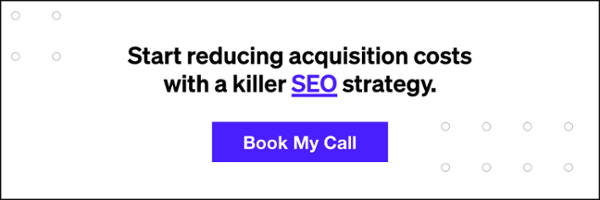Developing an effective search engine optimization (SEO) strategy can be challenging and time-consuming, especially for e-commerce sites which may not have content heavy pages. But SEO is still an important part of your site design to help increase revenue and traffic to your website. An optimal SEO strategy should be seen as a long term investment which will help new customers find your site and grow your business in a cost effective way. It won’t be easy, but once you have a strategy in place it will be worth it. Ready to get started? Keep reading!
Step 1: Technical SEO
Run a Website Crawl
Before you get started, you’ll want to evaluate where your site is now. You can do this by running a website crawl on your entire eCommerce website which will build a search index for the site and identify any issues. A crawl will show you if your site has duplicate or missing title tags, headers, meta descriptions, image alt text and more. Once these problems have been flagged, you’ll have a place to start. You can learn more about possible errors and how to fix those specific to your site by using Google’s Crawl Error Report.
Indexed Pages
After the crawl, you can identify how many pages on your site Google is indexing in the Search Console or by checking the search engine results page (SERP). The SERP is simply the page with results listed after a query is input to the search engine. To see how many pages Google has indexed on your site using the SERP, input the search query site:yourdomain.com in Google and view the results.
Be sure to utilize Google’s Index Status Report to help identify and resolve any possible indexing issues. You may discover duplicate content pages, problems with canonicalization, or automatically generated content, all of which can influence your indexing. Using a canonical tag will help prevent duplicate content errors by allowing you to identify a preferred version of a page for SEO reasons.
Step 2: Keyword Research
Before beginning your keyword research, you’ll want to start with an analysis of the keywords your site is currently ranking for. Specifically, you’re looking for opportunity keywords, or keywords which have a high volume of monthly searches, but a low number of competing pages. For example, if you are ranking on page two for a number of terms and those keywords have a high search volume, but aren’t very competitive, those are your opportunity keywords.
Related: Keyword Research Tips & Best Practices
With some on-page optimization tactics you can get your website onto page one in no time, increasing both your traffic and revenue as a result. You can amplify these keywords even more by building backlinks and utilizing internal links to give them as much power as possible.
Once you’ve completed an in-depth ranking analysis, you’ll want to look at three main factors: Keyword Intent, Search Volume, and Competition.
Keyword Intent
When you look at keyword intent you are trying to understand the intent or goal behind a user’s search. When using a particular phrase, are they looking for an answer to a specific question? Or are they looking to purchase something? Having the insight into what users are looking for helps you target the right keywords for your site.
For example, if your site sells mattresses you would want to target transactional keywords such as “buy mattress online” or “mattress for sale.” On the other hand, if you are writing a blog post about mattresses you would want to use information keywords such as “choosing the best mattress type for you.” As an eCommerce site, customers will most likely be using transactional keywords. So it’s a safe bet to start there.
Search Volume
As you are deciding which keywords to target, you’ll want to go after the ones with the highest search volume that are still relevant to your site. You wouldn’t want to target keywords that have high search volume but nothing to do with your site’s content. Google’s Keyword Planner is a great place to start when conducting this research. With this tool, you’ll be able to search keywords that are relevant to your site and see the average monthly searches for each, allowing you to have actionable data to make decisions.
Competition
You’ll also want to evaluate how competitive each keyword or phrase is by looking at the website’s domain authority (DA). The higher the DA the more difficult it will be to rank for any given keyword.
Step 3: On-Page SEO For E-Commerce Websites
Once you have the best keywords in place, you’ll want to address your on-page SEO tactics. Using Google Analytics, analyze how much organic traffic your website is getting. Then identify the highest performing pages on your site; those which are generating the most traffic and revenue. Finally, measure when you made updates to those pages and what the corresponding results were. This will give you a solid starting point in reference to what you’ve already been doing and how it has influenced your site. From there you can implement the following tips for on-page SEO.
On-Page SEO Tips for eCommerce Websites
Switch from HTTP to HTTPS
Google has stated that there is a slight ranking boost for websites using HTTPS instead of HTTP. So if your site is still using HTTP, switch your entire domain to HTTPS. The new format is also more secure for handling customer’s personal information and credit card data.
Optimize Category Pages
The category pages of an eCommerce website are vital to its success. By optimizing these pages correctly, you can drive traffic for top level keywords right to your site. Using transactional keywords in the title tags with purchase intent and adding any discounts to the title tag can be crucial ways to improve category page optimization. For example, have a title tag which reads “Buy Soccer Cleats – Up to 30% Off” will help increase the click-through-rate (CTR) for the page.
Related: How Much Written Content Should I Have on My E-Commerce Site?
You will also need to add content to your category pages to avoid thin content penalties from Google. We recommend at least 300 words and the content can be placed at the bottom of the page after all the products so as not to interrupt the shopper’s experience with heavy content blocks.
Optimize Product Pages
Similar to category pages, your product pages must be optimized to help drive traffic and revenue to your site. Updating the meta descriptions and title tags of each page can make a significant impact on your CTR, increasing the number of visitors that come from the search engine to the site. Just as with category pages, adding a discount to the title tag and using transactional keywords in the meta description will increase CTR. You may also consider placing short call to actions in the meta description to entice users to click through.
Optimizing your product pages in this way has recently become even more important with Google Panda’s update. Panda, one of Google’s most significant spam-fighting algorithms, was originally launched in February 2011. However, recently Google has added Panda into its core ranking algorithm permanently. As a result, Panda’s ability to consider the quality of a site is now a primary ranking factor for search engine results. Optimizing your product pages will increase the quality of your site and avoid ranking penalties from Google.
Schema on Product Pages
Be sure to markup your product pages with product rich snippets, or product schemas. Doing so will enhance your search result listing by placing additional information such as ratings, pricing, brand and stock levels.Additionally, research shows that adding product schemas increases both CTR and conversion rates.
Optimize Images on Product Pages
The spiders that crawl websites cannot see images the way humans do, so it’s important to optimize these images in order to gain traction with search engines. Here are some quick and easy ways to optimize your images:
- File Name Use words that accurately and clearly describe the image when naming the file. The name of the image file helps search engines determine what the content of the picture is. So use something like blue-denim-jacket instead of image01.
- Alt Text Alt text is provided as an alternative when websites can’t render the image. The alt text can also describe the image to search engines. Only use words relevant to the content of the image and try to use at least one keyword to take advantage of the text.
- Image Sizes Significant page load times impact your search ranking and image file sizes can play a huge role in your page load times. Keep file sizes as small as possible, under 100 KB, and don’t use HTML code to shrink it – this will increase load times.
- File Type Using the right file type can help keep file sizes smaller. JPEG is the most frequently used file type for eCommerce sites because it allows higher quality with a smaller file size.
Avoid Duplicate Content
If a search engine finds duplicate content on your site, it will penalize your ranking in the search results. In order to avoid these penalties, you can do a number of things on your site. First, create unique product descriptions for your product pages. Using the manufacturer’s description will likely be tagged as duplicate content. Or, as mentioned above, you can use a canonical link to identify a preferred version of a page for SEO reasons.
Step 4: SEO Outreach
After you’ve optimized your on-page strategy, you’re ready to increase your SEO outreach. This can be done in a number of ways, but the primary objective is simple: link building. Link building is the process of getting external pages to link back to your site to help drive rankings.
Wrapping Up
As you can see, SEO is not a short and easy process. But, if you commit to putting a strategy together your site can see enormous benefits including increased traffic and revenue. Start your plan by getting a handle on where your site stands currently, indexing your pages and understanding which keywords you are ranking for.
Then evaluate your opportunity keywords and act on them by improving your on-page SEO. Finally, build your SEO outreach to help increase your rankings. Once you’ve moved through all the steps, you’ll have a greater understanding of your site. But remember, SEO is a continuous process that demands constant monitoring. Contact the SEO experts today to learn more!








